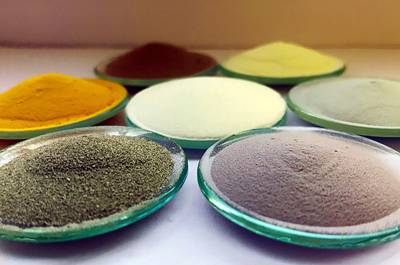The research group at Duisburg-Essen University has development an innovative 3D printing technique based on economical diode lasers to print coloured parts using polymer material coated with nanoparticles of silver.
“Instead of the CO2 lasers commonly used in the industry, our innovation relies on much cheaper diode lasers, such as those with lower output found in CD players,” said Dr. Bilal Gökce from the development group at the Technical Chemistry department at the University of Duisberg-Essen, Germany (UDE).
“However, you have to be a little tricky,” he added. “Because the usual polymer powder, the raw material for printing, is white. This means that it reflects all the wavelengths of the visible light – unfortunately including those of diode lasers.”
Multiple colors
The UDE the team had the idea to kill two birds with one stone: The scientists coated the powder grains with nanoscale particles made of silver. Their significant achievement is that these materials can have surprising properties: for example, silver appears yellow, while nanogold presents as red to violet. The work is reported in Advanced Optical Materials.
The previously white polymer was now yellow, and in combination with a diode laser, whose radiation is particularly well absorbed by yellow objects, the idea worked. The result is what the development group calls “the first laser-based desktop 3D printing in color”.
“Since the nanoparticles sit firmly on the surface of the powder grains and are not just mixed in, even a pinch of them gives a homogeneous color,” Gökce says. And what works with silver also works with nanoparticles of other elements.
There are no limits to the colors in this process. As a bonus, you also obtain other characteristics of the nanoparticles as well, such as the antibacterial effect of silver or the magnetic properties of iron oxide.
‘A new way for colored parts to be produced’
The Advanced Optical Materials paper abstract states: “Material development is key for continuing the exponential growth in the field of 3D printing. However, 3D printing of polymers by laser powder bed fusion (PBF‐LB) still is limited to a few polymer powder materials, which restricts the range of applications.
“Tailoring the chemical, rheological, mechanical, or optical properties of the feedstock powder to the requirements of the laser printing process poses a significant challenge.
“In order to meet global trends in the commercialization of desktop 3D printers, the use of inexpensive and compact diode lasers for PBF‐LB in the visible or near‐infrared range is highly desired. However, at present, only black objects can be printed by desktop laser printers since only commercial carbon black‐based composite powders meet their laser absorption requirements.
“In this study, a route for tuning the absorption properties of thermoplastic polyurethane polymers and incorporating color into printed objects by using minute amounts (i.e., 0.01 vol%) of highly dispersed plasmonic silver nanoparticles is reported, presenting a new way for colored parts to be produced through laser 3D printing.”


